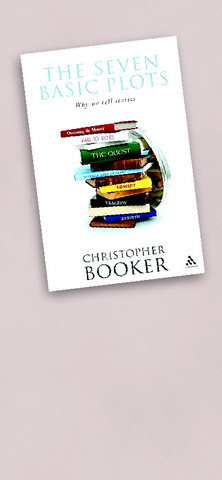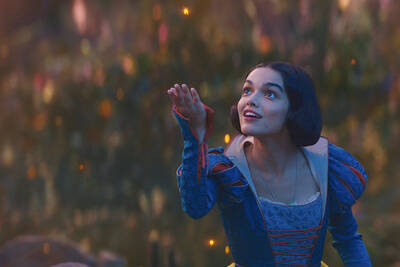So what does Steven Spielberg's shark-fest Jaws have in common with the Old English epic Beowulf?
And what do those two stories have in common with High Noon, The Guns of Navarone and most any James Bond movie?
What links David Copperfield, Jane Eyre and the legend of King Arthur together with the fairy tale The Ugly Duckling? What story line resurfaces in such disparate works as the Grail quest, Raiders of the Lost Ark, The Lord of the Rings and Richard Adams' bumptious bunny tale Watership Down?

What could Peter Rabbit, Scarlett O'Hara and Alice from Wonderland possibly have in common? Or Sleeping Beauty, Snow White, Silas Marner and Scrooge?
These aren't trick SAT questions or annoying Trivial Pursuit queries. They are questions that lie at the heart of the thesis that the critic Christopher Booker sets out in his gargantuan, sometimes absorbing and often blockheaded new book.
According to Booker, there are only seven basic plots in the whole world -- plots that are recycled again and again in novels, movies, plays and operas. Those seven plots are: 1. Overcoming the Monster, 2. Rags to Riches, 3. The Quest, 4. Voyage and Return, 5. Rebirth, 6. Comedy and 7. Tragedy.
The Overcoming the Monster plot lies behind horror movies and thrillers like Jaws, as well as many war stories, Hollywood westerns and science fiction tales. In this genre, a community dwells under the shadow of a monstrous threat; a hero or band of heroes does battle with the beast (be it a giant white shark, an evil gunslinger or a horde of Nazis); initial dreamlike success is followed by nightmarish setbacks; but a final confrontation results in victory for the hero, the vanquishing of the monster and the restoration of order to the realm.
In the Rags to Riches story line traced by works like Jane Eyre, an immature hero (often an orphan), who is looked down upon by others, has a series of adventures culminating in a terrible crisis, and emerges from those tests a mature person, ready at last to assume his or her place in the world and make a lasting love match.
Hazardous journeys filled with physical perils provide the structure both for Quest tales like Raiders of the Lost Ark and Voyage and Return and for narratives like Alice in Wonderland, while inner journeys (from naivete to wisdom, psychological paralysis to emotional liberation) form the armature of Rebirth tales like Snow White and A Christmas Carol.
In laying out these archetypes, Booker -- a British newspaper columnist and the founding editor of the satirical magazine Private Eye -- does a nimble job of colla-ting dozens of stories, using the 34 years he says it took him to write this volume to identify and explicate all sorts of parallels and analogies that might not occur to the casual reader. He shows us how The Terminator and its sequel Judgment Day adhere to traditional narrative tropes, moving inexorably if violently toward the ideas of rebirth and redemption. And he reminds us how the movie ET embodies classic coming-of-age-story patterns: The boy hero Elliott's encounter with ET, his alien alter ego, helps him to grow up, forces him to demonstrate leadership, and enables him to bring new harmony to his fragmented family. Booker suggests that five of the seven basic plots (Overcoming the Monster, Rags to Riches, the Quest, Voyage and Return, and Rebirth) can really be placed under the larger umbrella of Comedy: in their purest form, all have happy endings, all trace a hero's journey from immaturity to self-realization, and all end with the restoration of order or the promise of renewal.
In a sense, these plots all represent variations on Freud's family romance -- the process whereby a young person comes to terms with parental authority, ventures out into the wider world, faces assorted tests and eventually achieves independence. Along the way, confusion (be it a case of mismatched couples or a community in disarray) is dispelled, and alienation gives way to a new sense of wholeness and well-being. This is often symbolized, Booker argues, by a marriage that represents the coming together of masculine and feminine values and the achievement of balance among the four virtues of "strength, order, feeling and understanding."
Only in the seventh plot type, Tragedy, he observes, is there a deviation from this fundamental pattern. Here, the hero or heroine also goes on a journey, but is "held back by some fatal flaw or weakness from reaching that state of perfect balance," he writes. "They are doomed to fall short of the goal because in some way they are stuck in a state of incompleteness or immaturity."
The problem is that most of Booker's theories -- from his belief that archetypal stories are rooted in the human unconscious to his arguments about Tragedy and Comedy -- are highly familiar, lifted in part or whole from a wide spectrum of influential, even canonical works by writers and thinkers as varied as Jung, Freud, Joseph Campbell, Bruno Bettelheim, Sir James George Frazer, the Shakespeare scholar A.C. Bradley and the folklore experts Peter and Iona Opie.
Not only is Booker a voracious magpie (who does not always acknowledge the sources of his ideas), but he also turns out to be an annoyingly biased and didactic one. As The Seven Basic Plots progresses, it grows increasingly tendentious.
In the past two centuries, Booker complains, "a fundamental shift has taken place in the psychological `center of gravity' from which" stories have been told; as a result, "they have become detached from their underlying archetypal purpose."
Such inane readings of modern literature effectively eclipse the more engaging arguments presented in the first portion of Booker's book. Anyone tackling The Seven Basic Plots would be advised to peruse the informative first half and quickly ditch the second half of this 700-plus page tome.

That US assistance was a model for Taiwan’s spectacular development success was early recognized by policymakers and analysts. In a report to the US Congress for the fiscal year 1962, former President John F. Kennedy noted Taiwan’s “rapid economic growth,” was “producing a substantial net gain in living.” Kennedy had a stake in Taiwan’s achievements and the US’ official development assistance (ODA) in general: In September 1961, his entreaty to make the 1960s a “decade of development,” and an accompanying proposal for dedicated legislation to this end, had been formalized by congressional passage of the Foreign Assistance Act. Two

Despite the intense sunshine, we were hardly breaking a sweat as we cruised along the flat, dedicated bike lane, well protected from the heat by a canopy of trees. The electric assist on the bikes likely made a difference, too. Far removed from the bustle and noise of the Taichung traffic, we admired the serene rural scenery, making our way over rivers, alongside rice paddies and through pear orchards. Our route for the day covered two bike paths that connect in Fengyuan District (豐原) and are best done together. The Hou-Feng Bike Path (后豐鐵馬道) runs southward from Houli District (后里) while the

March 31 to April 6 On May 13, 1950, National Taiwan University Hospital otolaryngologist Su You-peng (蘇友鵬) was summoned to the director’s office. He thought someone had complained about him practicing the violin at night, but when he entered the room, he knew something was terribly wrong. He saw several burly men who appeared to be government secret agents, and three other resident doctors: internist Hsu Chiang (許強), dermatologist Hu Pao-chen (胡寶珍) and ophthalmologist Hu Hsin-lin (胡鑫麟). They were handcuffed, herded onto two jeeps and taken to the Secrecy Bureau (保密局) for questioning. Su was still in his doctor’s robes at

Mirror mirror on the wall, what’s the fairest Disney live-action remake of them all? Wait, mirror. Hold on a second. Maybe choosing from the likes of Alice in Wonderland (2010), Mulan (2020) and The Lion King (2019) isn’t such a good idea. Mirror, on second thought, what’s on Netflix? Even the most devoted fans would have to acknowledge that these have not been the most illustrious illustrations of Disney magic. At their best (Pete’s Dragon? Cinderella?) they breathe life into old classics that could use a little updating. At their worst, well, blue Will Smith. Given the rapacious rate of remakes in modern